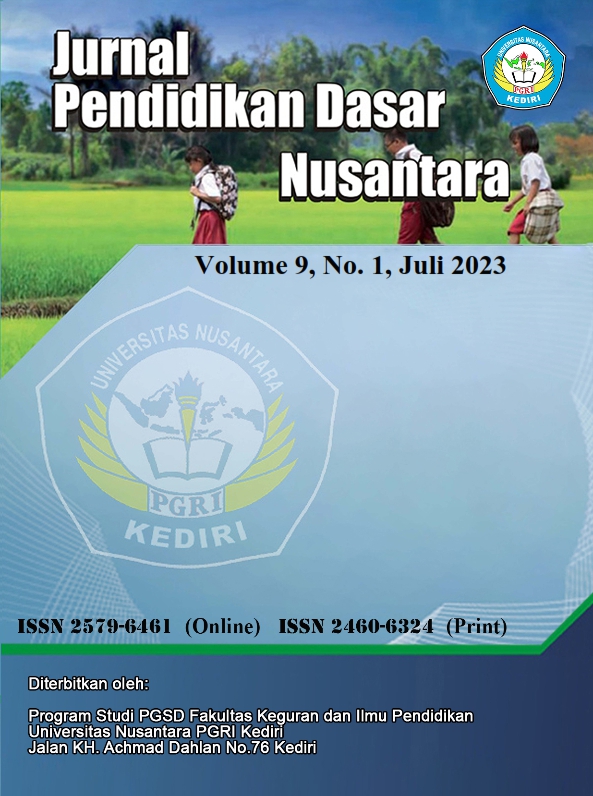Development of contextual teaching and learning based audiovisual learning videos in III grade of elementary school
DOI:
https://doi.org/10.29407/jpdn.v9i1.19164Keywords:
learning videos, contextual teaching and learning, food technology.Abstract
This research aimed to determine the development and feasibility of audiovisual learning videos based on the Contextual Teaching and Learning (CTL) approach, as well as to assess the students' response to the audiovisual learning videos on the topic of food technology. The method used in this research is Research and Development (RnD) from Borg & Gall. This development only used 6 steps out of 10 steps, this is because researchers only conduct research at one educational institution (school) and see the limited time, effort, and costs of researchers. Product assessment for the feasibility test of contextual teaching and learning based audiovisual learning videos was carried out by 3 experts, namely a media expert, language expert, and subject matter expert with the target of limited-scale product trials, that are students of class IIIB MIN 1 Tangerang City, totaling 30 people. The results of the feasibility assessment after validation by the experts are as follows: (a) media validation scored 80%; (b) language validation scored 82%; and (c) subject matter validation scored 76.5%. Consequently, the overall feasibility score for the audiovisual learning videos was 79.5%, indicating that the videos are considered "Feasible." Thus, these learning videos can be utilized by students to enhance the learning process by involving illustrations from the surrounding environment in the topic of food production technology. Furthermore, the students' response to the audiovisual learning videos based on CTL, as assessed through the product trial in Grade III B at MIN 1 Kota Tangerang, obtained a questionnaire response percentage of 90.6%, falling into the category of "Excellent." The survey results demonstrate that the students are enthusiastic about the learning process using the contextual video learning media.
Downloads
References
Akbar, Sa'dun. 2013. Instrumen Perangkat Pembelajaran. Bandung: Rosdakarya. Agustini, Ketut clan Jero Gede Ngarti. 2020. Pengembangan Video Pembelajaran untuk Meningkatkan Motivasi Belajar Siswa Menggunakan Model R&D. Jumal Imiah Pendidikan clan Pembelajaran. Vol. 4, No.1: 62-78.
Arikunto, Suharsimi. 2007. Prosedur Penelitian Suatu Pendekatan Praktik. Jakarta: PT. Rineka Cipta. Suharsimi. 2010. Prosedur Penelitian Suatu Pendekatan Praktik. Jakarta: Rineka Cipta.
Asyhar, Rayandra. 2012. Kreatif Pengembangan Media Pembelajaran. Jakarta: Gaung Persada Press.
Azhar, Arsyad. 2017. Media Pembelajaran. Jakarta: PT. Raja Grafindo Persada. Daryanto. 2014. Pendekatan Pembelajaran Saintifik Kurikulum 2013. Jakarta: GavaMedia.
Djuanda, Dadan. 2006. Pembelajaran Bahasa Indonesia Yang Komunikatif Dan Menyenangkan. Jakarta: Departemen Pendidikan Nasional. Harjanto. 2003. Perencanaan Pengajaran. Jakarta: PT. Rineka Cipta
Indriana, Dina. 2011. Ragam Alat Bantu Media Pembelajaran. Yogyakarta: Diva Press.
Kemdikbud. 2020. Surat Edaran Mendikbud: Pelaksanaan Kebijakan Pendidikan dalam Masa Darurat Penyebaran Covid-19. (https://www.kemdikbud.go.id/main/blog/2020/03/se-mendikbud• pelaksanaan-kebij akan-pendidikan-dalam-masa-darurat-penyebaran• covid19, diakses pada tanggal 13 Desember 2020, pukul 10:30 WIB).
Kumiawan, Deni. 2014. Pembelajaran Terpadu Tematik (Teori, Praktik dan Penilaian). Bandung: Alfabeta.
Majid, Abdul. 2014. Strategi Pembelajaran. Bandung: PT Remaja Rosdakarya
Nanda, Khrisna Kadek., dkk. 2017. Pengembangan Video Pembelajaran Berbasis Pendekatan Kontekstual Kelas V di SD Negeri 1 Baktiseraga. Jumal Edutech Universitas Pendidikan Ganesha, Vol. 05, No. 1: 88-99
Purwono, Urip. 2008. Standar Penilaian Bahan Ajar. Jakarta: BNSP. Riduwan. 2009. Dasar-Dasar Statistika. Bandung: Alfabeta.
Riduwan. (2013). BelajarMudah Penelitian untuk Guru Karyaawan dan Peneliti Pemula. Bandung: Alfabeta.
Rofa'ah. (2016). Pentingnya Kompetensi Guru dalam Kegiatan Pembelajaran dalam PerspektifIslam. Yogyakarta: Deepublish.
Rusman. 2012. Model-Model Pembelajaran. Depok: PT. Rajagrafindo Persada. Sagala, Syaiful. 2005. Konsep dan Makna Pembelajaran. Bandung: Alfabeta.
Sanjaya, W. (2018). Strategi Pembelajaran Berorientasi Standar Proses Pendidikan. Jakarta: Prenadamedia Group
Shoimin, Aris. 2014. 68 Model Pembelajran Inovatif Dalam Kurikulum 2013. Yogyakarta: Ar-Ruzz Media.
Sugiyono. 2019. Metode Penelitian Kuantitatif, Kualitatif dan R&D. Bandung: Alfabeta. 2015. Metode Penelitian dan Pengembangan (Research and Development). Bandung: Alfabeta.
Supandi. 1992. Teori Belajar Motorik. Bandung: FPOK
Suprijono, Agus. 2014. Cooperative Learning. Yogyakarta. Pustaka Pelajar
Trianto. 2010. Model-Model Pembelajaran Terpadu. Jakarta: Bumi Aksara. Widoyoko, S. Eko Putro. 2014. Teknik Penyusunan Instrumen Penelitian. Yogyakarta: Pustaka Pelajar.
Raihanti, Jamaludin, & Taufik. 2020. Pengembangan Media Pembelajaran Audio Visual Powtoon Berbasis Kontekstual Pada Mata Pelajaran IPS Kels IV. Attadib: Journal of Elementary Education, Vol. 4 (2).
Downloads
Published
Issue
Section
License
Authors who publish with this journal agree to the following terms:
- Copyright on any article is retained by the author(s).
- The author grants the journal, the right of first publication with the work simultaneously licensed under a Creative Commons Attribution License that allows others to share the work with an acknowledgment of the work’s authorship and initial publication in this journal.
- Authors are able to enter into separate, additional contractual arrangements for the non-exclusive distribution of the journal’s published version of the work (e.g., post it to an institutional repository or publish it in a book), with an acknowledgment of its initial publication in this journal.
- Authors are permitted and encouraged to post their work online (e.g., in institutional repositories or on their website) prior to and during the submission process, as it can lead to productive exchanges, as well as earlier and greater citation of published work.
- The article and any associated published material is distributed under the Creative Commons Attribution-ShareAlike 4.0 International License

































